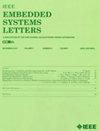比较 XML 和 JSON 作为超低功耗嵌入式系统数据序列化格式的特点
IF 2
4区 计算机科学
Q3 COMPUTER SCIENCE, HARDWARE & ARCHITECTURE
引用次数: 0
摘要
Javascript对象表示法(JSON)和可扩展标记语言(XML)是在许多应用程序(包括客户机-服务器传输、Internet通信和大规模数据存储)中比较过的两种数据序列化方法。由于文件大小较小,JSON传输数据的速度更快。但是,XML更适合发送复杂的数据结构。这封信比较了嵌入式系统背景下的两种数据格式,考虑了诸如时间、内存和功率等因素,以确定每种方法的有效特征。针对相同的数据集编写、优化和比较了每种格式的程序。JSON文件比XML文件小24.7%。这导致了更短的程序运行时间和更少的电力消耗时,读取和处理文件。然而,反序列化XML文件的程序比其JSON对应程序占用的闪存少16.7%。总的来说,在收集大量数据、需要高速通信或在电池充电之间运行较长时间时,发现JSON是系统的更好选择。但是,XML是为具有有限闪存的系统提出的。本文章由计算机程序翻译,如有差异,请以英文原文为准。
Comparing XML and JSON Characteristics as Formats for Data Serialization Within Ultralow Power Embedded Systems
Javascript object notation (JSON) and extensible markup language (XML) are two data serialization methods that have been compared over many applications, including client-server transmission, Internet communication, and large-scale data storage. Due to the smaller file size, JSON is faster for transmitting data. However, XML is better for sending complex data structures. This letter compares the two data formats in the context of an embedded system, considering factors, such as time, memory, and power to identify efficient characteristics of each method. Programs for each format were written, optimized, and compared for the same dataset. The JSON file was found to be 24.7% smaller than the XML file. This led to a shorter program run-time and less power being consumed when reading and processing the file. However, the program to deserialize the XML file took up 16.7% less flash memory than its JSON counterpart. Overall, JSON was found to be a better choice for systems when collecting large amounts of data, requiring high speed communication, or running for an extended period between battery charges. However, XML is proposed for systems that have limited flash memory.
求助全文
通过发布文献求助,成功后即可免费获取论文全文。
去求助
来源期刊

IEEE Embedded Systems Letters
Engineering-Control and Systems Engineering
CiteScore
3.30
自引率
0.00%
发文量
65
期刊介绍:
The IEEE Embedded Systems Letters (ESL), provides a forum for rapid dissemination of latest technical advances in embedded systems and related areas in embedded software. The emphasis is on models, methods, and tools that ensure secure, correct, efficient and robust design of embedded systems and their applications.
 求助内容:
求助内容: 应助结果提醒方式:
应助结果提醒方式:


